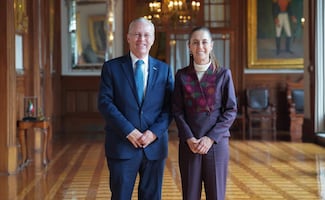Más Información

Sheinbaum se reúne con José Medina Mora en Palacio Nacional; asumirá la presidencia del CCE el 10 de diciembre, detalla

EU entregó a México lista con nombres de espías rusos, reporta el NYT; el gobierno mexicano los dejó quedarse, dice

Embajada de EU pide información sobre paradero de Ryan Wedding, exatleta ligado al Cártel de Sinaloa; recompensa es de 15 mdd

Sheinbaum entra a la lista de las 67 personas más elegantes de 2025; The New York Times destaca los bordados mexicanos en su indumentaria

“Es un camino largo, pero con amor lo hace uno”; peregrinos de diversos estados comienzan a llegar a la Basílica de Guadalupe
Members of the Federal Tribunal of Administrative Justice (TFJA) unanimously ruled that Andrés León Reguera and Juan Alberto Bravo Hernández must return MXN 216.3 million and MXN 230.8 million after simulating the purchase of stainless steel at a higher price during the construction of the Stele of Light (Estela de Luz), a monument located in Mexico City.
Federal authorities built the monument in 2011 to commemorate the bicentenary of Mexico's independence from Spain; however, corruption claims have surrounded the project for years.
Andrés León Reguera and Juan Alberto Bravo Hernández worked for III Servicios, Pemex’s subsidiary. The company was in charge of hiring the private construction companies that build the monument. Both León Reguera and Bravo Hernández were involved in the construction process.
Magistrate Nora Elizabeth Urby Genel presented the case before the federal tribunal. The judge argued the sanction was established after the Superior Audit Office (ASF) found irregularities in March 2019.
Recommended: Pemex: 20 years of corruption, fraud, and fuel theft
Magistrate Urby Genel said Andrés León and Juan Alberto Bravo reported a change in the stainless steel that was to be used in the project on April 28, 2010. The change implied an increase of MXN 316.5 million in the construction project; however, they didn’t change the stainless steel or the diameter.
León Reguera and Bravo Hernández contested the decision made by the ASF in 2019, under the argument that their actions did not harm the treasury because federal authorities allocated the resources from Banjército and it was paid to III Servicios; nevertheless, the magistrate said the resources were misused and this cause financial damages.
Academics José Manuel Falcón and Carlos Domenzain published an academic article denounced the corruption in the construction of the Stele of Light in 2015. The article is titled “México City’s Stele of Light: Corruption on a Monumental Scale.”
The researches explain “The México City monument, “Stele of Light”, has been nicknamed “the Monument to Corruption” thanks to a history plagued by scandal. The competition’s brief asked for a commemorative arch but was won by a monument of steel and luminescent quartz that soars some 30 stories into the sky. Its construction was fraught with diverse frauds that increased the budget threefold. Despite the expense, this work, intended to represent the transition of the country into cutting-edge modernity, has not been accepted as an inspirational symbol, nor is it an example of ‘place-making’ in the city. This paper recounts the history of this failure and reflects upon it in the context of theoretical discussions about monuments and memorials. Finally, the authors open the possibility that the nickname “monument to corruption” be understood as more than merely an ironic title, and that the structure might be edifying in ways unintended by its designers.”
Recommended: Peña and Calderón allegedly received millions from drug cartel
gm
Noticias según tus intereses
[Publicidad]
[Publicidad]









